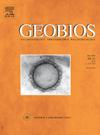印度古近纪晚期发现的最早的石桐属(石桐科)化石表明其起源于冈瓦纳
IF 1.6
4区 地球科学
Q2 PALEONTOLOGY
引用次数: 0
摘要
红心科植物在全球热带和亚热带地区具有重要的生态和经济作用。金貂草属。是一个常绿属,主要局限于东南亚。本研究报道了印度东北部阿萨姆邦Makum煤田晚渐新世(~ 24-23 Ma)沉积物中最早的Swintonia化石记录,为该属的进化史提供了新的见解。这里描述的化石叶子代表了一种Swintonia floribunda Griff。将其归入阿纳卡亚科。这一发现支持了红心科的冈瓦纳起源,印度在其早期多样化和分散中起着关键作用。此外,它丰富了该科的古近纪化石记录,并表明该属起源于印度,随后迁移到东南亚。渐新世晚期Swintonia的出现表明,该属出现的时间比之前认为的要早,在印度次大陆温暖潮湿的气候中茁壮成长。这一发现增强了我们对其进化发展和生物地理分布的认识。本文章由计算机程序翻译,如有差异,请以英文原文为准。
Earliest Swintonia (Anacardiaceae) fossil from the late Paleogene of India suggests its Gondwanan origin
The Anacardiaceae family plays a vital ecological and economic role in tropical and subtropical regions globally. The genus Swintonia Griff. being an evergreen genus is confined largely to Southeastern Asia. This study reports the earliest fossil record of Swintonia from the late Oligocene (∼24–23 Ma) sediments of the Makum Coalfield, Assam, northeast India, offering new insights into the evolutionary history of the genus. The fossil leaf described here represents the species Swintonia floribunda Griff., placing it within the subfamily Anacardioideae. This finding supports the Gondwanan origin of the Anacardiaceae family, where India plays a pivotal role in its early diversification and dispersal. Further, it enriches the Paleogene fossil record of the family and suggests an Indian origin for the genus, followed by its subsequent migration to Southeast Asia. The presence of Swintonia in the late Oligocene indicates that the genus emerged earlier than previously thought, thriving in the warm and humid climate of the Indian subcontinent. This finding enhances our understanding of its evolutionary development and biogeographic distribution.
求助全文
通过发布文献求助,成功后即可免费获取论文全文。
去求助
来源期刊

Geobios
地学-古生物学
CiteScore
3.30
自引率
6.20%
发文量
28
审稿时长
6-12 weeks
期刊介绍:
Geobios publishes bimonthly in English original peer-reviewed articles of international interest in any area of paleontology, paleobiology, paleoecology, paleobiogeography, (bio)stratigraphy and biogeochemistry. All taxonomic groups are treated, including microfossils, invertebrates, plants, vertebrates and ichnofossils.
Geobios welcomes descriptive papers based on original material (e.g. large Systematic Paleontology works), as well as more analytically and/or methodologically oriented papers, provided they offer strong and significant biochronological/biostratigraphical, paleobiogeographical, paleobiological and/or phylogenetic new insights and perspectices. A high priority level is given to synchronic and/or diachronic studies based on multi- or inter-disciplinary approaches mixing various fields of Earth and Life Sciences. Works based on extant data are also considered, provided they offer significant insights into geological-time studies.
 求助内容:
求助内容: 应助结果提醒方式:
应助结果提醒方式:


